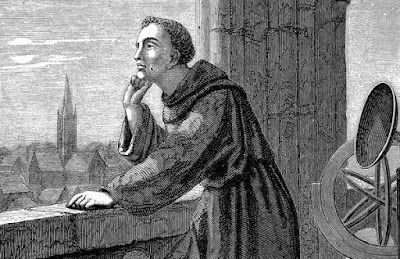He was born in Calabria c.1135 to a good family who made sure he was educated to become a clerk of the courts and then follow his father's footsteps and become a notary.
On a pilgrimage to the Holy Land c.1159 he experienced a spiritual conversion that made him turn away from a worldly life. On his return to Calabria, he became a hermit, wandering and preaching for several years although he did not join an order. Lay preaching was not always an acceptable practice to church authorities, who pressured him to "form Alize" his actions by joining the monks of the Abbey of Corazzo, where he was ordained c.1168. He began studying Scripture intently, certain that there was meaning hidden there that had not yet been revealed or understood. He was especially concerned with the apostle John's book of Revelation.
Around this time he had become a counselor to Margaret of Navarre, mother and regent for the underage William II of Sicily, where he probably met Peter of Blois.
About 1177 the monks of Corazzo, impressed by his scholarship and piety, made him their abbot, a responsibility and authority which he did not crave. In 1182, after trying and failing to join Corazzo to the Cistercian Order because of Corazzo's poverty, and convincing William II of Sicily to grant Corazzo some lands, he got permission from Pope Lucius III to step down as abbot and find another home. Joachim went to the Abbey of Casamari, which had recently changed from Benedictine to the more strict Cistercian Order. There he wrote three books: The Harmony of the New and Old Testaments, Exposition of Apocalypse, and the Psaltery of Ten Strings.
He was one of those rare people in this era who was writing things people had not said before, but did not get declared heretical. Lucius III and succeeding popes approved of what he was saying, and his fame spread. Constance the Empress of Sicily invited him to hear her confession, and left her raised chair to sit on the ground when he pointed out the need to humble herself. Richard the Lionheart met with him prior to the Third Crusade to get advice. The Spirituals of the Franciscans declared him a prophet (which Joachim denied).
In 1200 he submitted all of his writing to Pope Innocent III for examination and approval. Sadly, he died in 1202 before the results and before he could finish his final book, Tract on the Four Gospels, but his works were copied and distributed widely.
What was it that he wrote that created such an impact that, 800 years later, a pope would call his work a turning point and a scholar would call him the man who invented the future? I'll go. explain that tomorrow, but leave you with this teaser: by "future" Searle did not mean he predicted what things would be like in the future. Searle meant that Joachim invented the concept of the future. Stay tuned.












